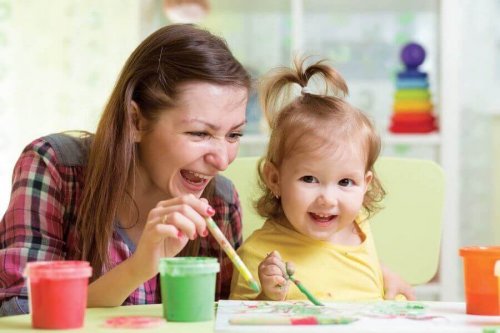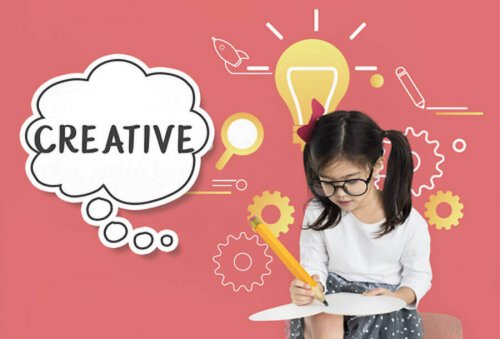How to Stimulate Creative Thinking in Children

Many parents wonder how they can stimulate creative thinking in their children and how it’d benefit them educationally speaking. This is because doing activities that nurture and enhance children’s talents from an early age will undoubtedly enable them to develop to the fullest.
In the first years of life, children are naturally interested in learning and discovering new things and have limitless creativity.
However, as they grow older, children may lose their imagination and stop developing their potential. To avoid this, we’ve decided to offer interesting tips to help you boost your child’s intelligence and creativity.
Curiosity, the first engine
Children are curious about everything around them. As such, you can’t deny that their eagerness to learn and experience everything is the engine that allows them to develop their talents, which will benefit them later on as adults.
Educational programs are constantly inserting new educational and teaching models to stimulate creative thinking in children and, thus, boost their development. However, this task isn’t exclusive to academic instruction.
Even toy and entertainment companies are focusing on awakening children’s talents. Furthermore, regarding home instruction, parents have also joined this campaign to help their children develop their intellectual capacity.
How to stimulate creative thinking in children
In order for children to develop their full creative potential and become intelligent, comprehensive, and competent individuals, experts believe they must be continually stimulated at a cognitive, social, and emotional level.
For this purpose, children should be exposed to appropriate stimuli such as language, the arts, exercise, manual skills, and emotional intelligence.
Language
Reading is one of the fundamental pillars for children to develop their language and intelligence and let their imagination run wild. It’s important that you start talking to them right from the moment they’re born so they can start developing their communication skills.
Likewise, once your children learn to read, you should encourage them to do it often. In addition, you should read with your children to boost their imagination and language and help them become more analytical.
The arts help stimulate creative thinking in children
Being exposed to artistic manifestations such as painting or music helps develop children’s motor skills. In addition, this helps children learn to improve their visual-spatial abilities, hearing, coordination, accuracy, knowledge of their own body, and new ways to express their ideas.

Physical exercise can also stimulate creative thinking
Sports help boost children’s motor skills, visual field, oral expression, and mathematical understanding. Physical exercise and games that allow your children to use their logical thinking and creativity stimulate brain connections to the fullest.
Manual skills
Manual skills, including construction sets, are very popular because they offer many positive stimuli. They help develop logical and creative thinking and boost children’s visual and tactile stimuli.
Emotional intelligence
A happy and loved child will focus on learning and letting her imagination run wild, not on her emotional deprivation. Therefore, it’s essential for children to learn to manage their emotions. They should also make appropriate bonds with their social environment.

As a final recommendation, remember that encouraging children to color, play dress-up, write plays, build modeling clay figures, and generally do any artistic activity from an early age will help stimulate creative thinking.
Many parents wonder how they can stimulate creative thinking in their children and how it’d benefit them educationally speaking. This is because doing activities that nurture and enhance children’s talents from an early age will undoubtedly enable them to develop to the fullest.
In the first years of life, children are naturally interested in learning and discovering new things and have limitless creativity.
However, as they grow older, children may lose their imagination and stop developing their potential. To avoid this, we’ve decided to offer interesting tips to help you boost your child’s intelligence and creativity.
Curiosity, the first engine
Children are curious about everything around them. As such, you can’t deny that their eagerness to learn and experience everything is the engine that allows them to develop their talents, which will benefit them later on as adults.
Educational programs are constantly inserting new educational and teaching models to stimulate creative thinking in children and, thus, boost their development. However, this task isn’t exclusive to academic instruction.
Even toy and entertainment companies are focusing on awakening children’s talents. Furthermore, regarding home instruction, parents have also joined this campaign to help their children develop their intellectual capacity.
How to stimulate creative thinking in children
In order for children to develop their full creative potential and become intelligent, comprehensive, and competent individuals, experts believe they must be continually stimulated at a cognitive, social, and emotional level.
For this purpose, children should be exposed to appropriate stimuli such as language, the arts, exercise, manual skills, and emotional intelligence.
Language
Reading is one of the fundamental pillars for children to develop their language and intelligence and let their imagination run wild. It’s important that you start talking to them right from the moment they’re born so they can start developing their communication skills.
Likewise, once your children learn to read, you should encourage them to do it often. In addition, you should read with your children to boost their imagination and language and help them become more analytical.
The arts help stimulate creative thinking in children
Being exposed to artistic manifestations such as painting or music helps develop children’s motor skills. In addition, this helps children learn to improve their visual-spatial abilities, hearing, coordination, accuracy, knowledge of their own body, and new ways to express their ideas.

Physical exercise can also stimulate creative thinking
Sports help boost children’s motor skills, visual field, oral expression, and mathematical understanding. Physical exercise and games that allow your children to use their logical thinking and creativity stimulate brain connections to the fullest.
Manual skills
Manual skills, including construction sets, are very popular because they offer many positive stimuli. They help develop logical and creative thinking and boost children’s visual and tactile stimuli.
Emotional intelligence
A happy and loved child will focus on learning and letting her imagination run wild, not on her emotional deprivation. Therefore, it’s essential for children to learn to manage their emotions. They should also make appropriate bonds with their social environment.

As a final recommendation, remember that encouraging children to color, play dress-up, write plays, build modeling clay figures, and generally do any artistic activity from an early age will help stimulate creative thinking.
All cited sources were thoroughly reviewed by our team to ensure their quality, reliability, currency, and validity. The bibliography of this article was considered reliable and of academic or scientific accuracy.
- Carolina, M., & Pérez, L. (2005). La evaluación de la creatividad. Perú. https://doi.org/10.1016/S0140-6736(11)60283-3
- Fallis, A. . (2013). Creatividad. Journal of Chemical Information and Modeling. https://doi.org/10.1016/j.jadohealth.2011.12.022
- Ferrando, M., Prieto, M. D., Ferrándiz, C., & Sánchez, C. (2005). Inteligencia y creatividad. Electronic Journal of Research in Educational Psychology. https://doi.org/10.1007/978-3-658-20589-8
This text is provided for informational purposes only and does not replace consultation with a professional. If in doubt, consult your specialist.








